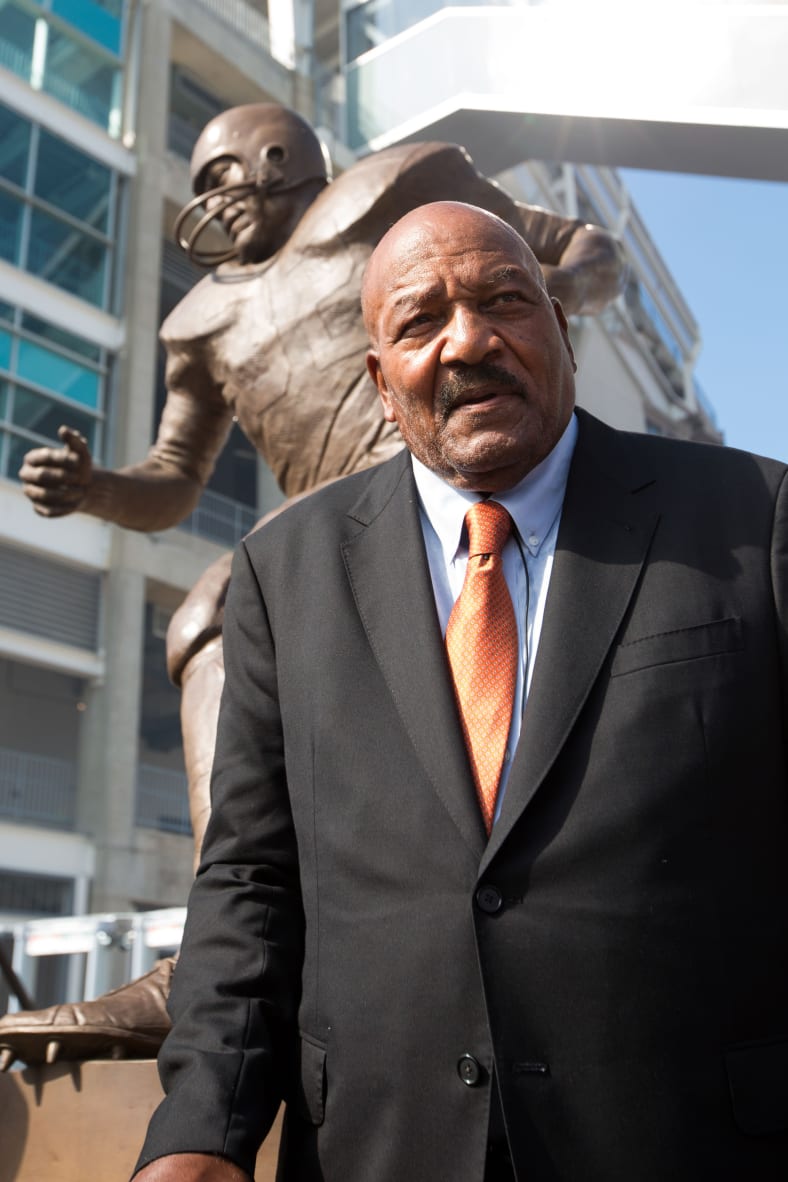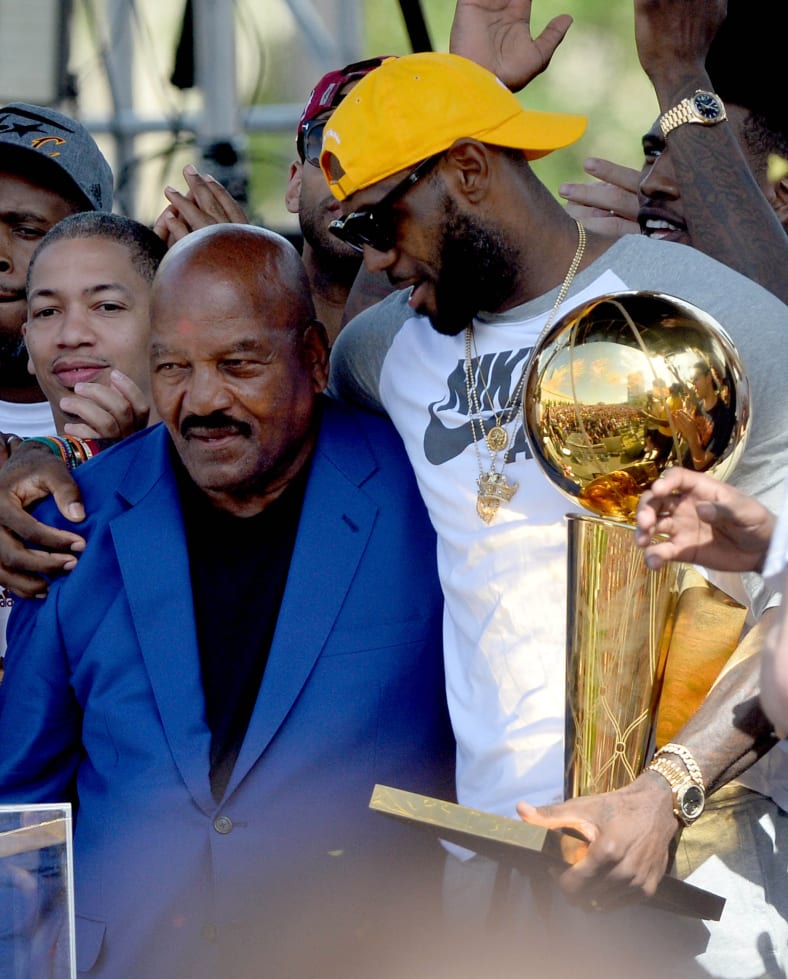NFL giant and civil rights icon Jim Brown dies at age 87
The sports legend was a prominent advocate for civil rights whose legacy is both remarkable and complex.
A craftsman on the football gridiron, Jim Brown was widely considered one of the greatest running backs in the National Football League’s history.
During his nine seasons with the Cleveland Browns, Brown led in rushing yards for eight of them. He led in rushing touchdowns for five of those seasons. He was selected the most valuable player in the NFL three times during his career and played for the Browns team that won the NFL Championship (later to be known as the Super Bowl) in 1964.
“Yardage isn’t the big thing. Having your team win the championship is,” he once said. “That’s what I work for, winning the championship, and this requires a certain standard of performance.”

Brown passed away at the age of 87 on May 18, 2023.
James Nathaniel Brown was born Feb. 17, 1936, on St. Simons Island, an all-Black community off the southern coast of Georgia. His father Swinton Brown was a professional boxer; his mother Theresa Brown was a domestic worker in Manhasset, New York. His grandmother was his main caretaker until he was eight at which time his mother sent for him to join her in Manhasset.
Brown thrived in his New York hometown. It was at Manhasset High School that he realized his prowess as an athlete. He earned 13 letters playing football, lacrosse, baseball, basketball and in track and field. During his senior year alone, he averaged 14.9 yards per carry on the football field, earning himself a spot at Syracuse University.
A Multisport Savant
At Syracuse, Brown excelled as a multisport athlete, playing basketball, baseball, lacrosse and running track. By his senior year in 1956, he was first-team All-American in both football and lacrosse. (Brown was inducted into the U.S. National Lacrosse Hall of Fame in 1983, the first Black athlete to have this honor). He told The New York Times in 1984 that, “Lacrosse is probably the best sport I ever played.”
Of his various sports, Brown really stood out in football, gaining national attention for his explosive play. In his senior year alone, he set two records at Syracuse: one for season rushing average and the other for scoring the most rushing touchdowns in a single game. During his senior year, he ran a total of 986 yards, the third-most in the country. In the final regular-season game of his senior year, he rushed for 197 yards, scoring six touchdowns and kicking seven extra points for a school-record 43 points. He came in fifth in voting for the Heisman Trophy.
The Cleveland Browns drafted Brown in 1957. He was the sixth overall pick in the draft and he did not disappoint in performance. In his first season, he gained nearly 1,000 rushing yards, earning the league’s Rookie of the Year award. He continued to post astonishing season totals in his brief career, routinely surpassing 1,000 rushing yards. In 1963, he ran for 1,863 yards, the most in a single season at that time and still the franchise’s highest. In 1962 in a down year, Brown would rush for only 996 yards.
In 1964, he led his team to the NFL championship against the Baltimore Colts in a 27-0 rout. Brown ran for 114 yards.

Controversies
Though Brown had a sterling football career, it and his personal life had their share of controversy involving women and violence. In his latter years, former Playboy employees featured in the A&E docuseries, “Secrets of Playboy,” accused him of assault. Brown and his representatives did not publicly respond to the allegations. Following Hugh Hefner’s death in 2017, Brown praised him, calling him “such a gracious person.”
In 1968, following nine years of marriage, his first wife Sue Brown sued him for divorce, claiming “gross neglect” on his part. The couple had three children, including twins, Kima and Kevin, and another son, James Jr.
Between 1965 and 1999, he faced numerous allegations of assault and sexual assault from multiple women. He was arrested at least three times — once on charges of assault and battery against an 18-year-old woman in 1965 and once on charges of raping a 33-year-old woman in 1985. Also in 1999, he was convicted of smashing the window of a car owned by his second wife Monique Brown (whom he married in 1997). He refused to attend counseling and had to serve a six-month jail sentence in 2002.
Life After Football
Toward the end of his football-playing days, he took on another career path: acting. He made his debut in the 1964 western action film, “Rio Conchos.” He landed a big role in MGM’s “The Dirty Dozen,” which filmed in London in early 1966.
Weather-related production delays filming “The Dirty Dozen” forced Brown to miss the first part of training camp, leading Browns’ owner Art Modell to threaten to fine him for each week he missed. The discord between the two became public. Brown said at the time about the threats, “Intimidation doesn’t work with me.”

And in a final response, Brown shocked the football world and announced his retirement at age 30 — at the height of his football career — to pursue acting.
Many doubted the wisdom of his decision. Yet, Brown was featured in more than 50 films and television shows — out of which he was the learning man in 16 films. The list includes “Dark of the Sun” (1967), “100 Rifles” (1969), “Slaughter” (1972) and “Three the Hard Way” (1974). He had smaller roles in “Mars Attacks!” (1996) and “Any Given Sunday” (1999, in which he played a football coach).
Football still played a role in Brown’s life after his retirement. He was inducted into the Pro Football Hall of Fame in 1971. He returned to the game as a sports commentator, teaming with Vin Scully and George Allen for CBS in 1978.
Brown entertained the idea of returning to the football gridiron full time in 1983 when it seemed Pittsburgh Steelers running back Franco Harris might break Brown’s all-time rushing record. He considered playing for the Los Angeles Raiders but to no avail. Harris fell short of breaking the record.
From 2005 to 2010, Brown served as executive adviser to the Browns and later was tapped to be special adviser to the team. In 2016, he was honored with a statue outside Cleveland’s FirstEnergy Stadium. In January 2020, during halftime of the college football national championship game, he was recognized as the top college football player ever.
Social Activism
Utilizing his prominence as a public figure, Brown showed his support for the Black community and has been known to lash out at athletes who have not done the same.
In 1957, he helped develop the Negro Industrial and Economic Union, a Black capitalist organization that was established to bolster investment and technical support for Black-owned businesses. In 1988, he founded the Amer-I-Can Foundation for Social Change, a program that is aimed at helping at-risk youths in underserved communities in Los Angeles and Cleveland.
Brown is survived by his second wife, Monique, and their child, the Associated Press reports. He was married to his first wife, Sue Brown, for 13 years and they had three children.
TheGrio is FREE on your TV via Apple TV, Amazon Fire, Roku, and Android TV. Please download theGrio mobile apps today!
More About:Featured

